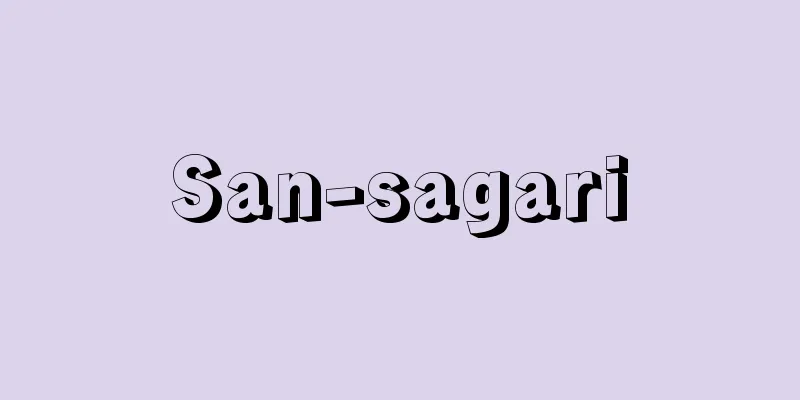Augsburg - Augsburg (English spelling)

|
A city in Bavaria, southern Germany. It is located at the confluence of the Lech and Bertach rivers, which flow north from the Alps. It has a population of 255,000 (2000). Since the construction of the railway, its relative status has declined due to the development of Munich, but it prospered as the leading commercial and industrial city in southern Germany, especially in the Middle Ages. The foundations of the city were built by the ancient Romans on the left bank of the Bertach River, and the current downtown area, Maximilianstrasse, was once the site of a merchant's town. Later, the city expanded into the lowlands along the Lech River, canals were built, and industries such as flour milling and iron forging developed using waterwheels. The city fell into decline for a time, but in the 19th century it was revived with the development of spinning, weaving, and machine industries using water turbines. Today, the automobile and electronics industries are also well developed. It was also a cultural center, and produced many cultural figures, including the painter H. Holbein and his son, and the architect E. Hol, who was involved in the city planning and built the city hall. The city has many historical buildings that show its long traditions, such as the Renaissance-style city hall, the Dome, famous for its bronze door, the Fugger family residence, and the Fuggerei district (the world's first poor housing district built by the Fugger family). In a park in the southwest of the city, a monument to R. Diesel, the inventor of the diesel engine, who once lived here, was erected by a Japanese person. [Hideya Ishii] historyThe city's origins date back to the Roman city of Augusta Vindelicorum, founded around AD 10-30 on the site of a Roman legionary camp established in 15 BC. A bishopric was established in the early Middle Ages, and Bishop Ulrich worked with Otto I to prevent the invasion of the Magyars (955) and built the foundations of a bishopric. It has long been a key transportation point connecting Germany and Italy, and in the 11th century a merchant town developed (the first city law was enacted in 1156). In the second half of the 13th century, the bishop's authority was largely transferred to the citizens, and autonomy advanced, becoming an imperial city in 1315. From 1368, for 180 years, the participation of the zunft (professional guild) in city administration was realized in contrast to the city aristocracy. In the 15th and 16th centuries, the city was known as "Golden Augsburg" due to its thriving economic activities, including trade with Venice, the center of Mediterranean trade, valgend weaving and metalwork, the mining, refining and sale of silver and copper in the Tyrol region, and financial services. The population was 32,000 in 1550 and 46,000 in 1612. Many great merchants, including the Fugger and Welser families, came from the city, and their activities extended throughout Europe and even the "New World." During the Reformation, the Imperial Diet was held many times, and the Peace of Augsburg (1555), which officially recognized Lutheranism, was also concluded here. Under the influence of the Commercial Revolution, the city retreated from the field of global commerce, but in the 18th century it became the center of the emerging calico printing industry. Schule, the "King of Calico in Germany," is a representative example. The housewarming celebration for the Schaetzler House, a masterpiece of Rococo architecture, was a welcoming ball for Marie Antoinette, who was to marry into the French royal family. In 1806, the city was incorporated into the Kingdom of Bavaria after the dissolution of the Holy Roman Empire, and the cotton industry developed during the Industrial Revolution. In 1837, the Augsburg Machine Cotton Spinning Company (30,000 spindles, 800 looms, capital of 1.2 million gulders, annual production of 100,000 bolts of cloth; today's Augsburg Machine Cotton Spinning Company, or SWA) was established, and in 1840, a railway line to Munich was opened, and in 1842, the Chamber of Commerce was established. National economist and pioneer of railway construction, List, came to the city as a collaborator of the newspaper Allgemeine Zeitung, and completed his major work, The National System of Political Economy. In 1866, the last German Bundestag was held at the Hotel Drei Mohren, and a resolution was passed to dissolve the city. In 1897, a diesel engine was completed in a machine factory (now the Augsburg-Nuremberg Machine Factory, or MAN) established in 1840. By 1910, the population had exceeded 100,000. During World War II, it was heavily damaged by air raids in 1944 and fighting in 1945. [Minoru Morota] [Reference] |Source: Shogakukan Encyclopedia Nipponica About Encyclopedia Nipponica Information | Legend |
|
ドイツ南部、バイエルン州にある都市。アルプスから北流するレッヒ川とベルタハ川の合流点に位置する。人口25万5000(2000)。鉄道が敷かれてから以後は、ミュンヘンの発達で相対的な地位の低下は否めないが、とくに中世には南ドイツ随一の商工業都市として繁栄した。町の基礎は、古代ローマ人によってベルタハ川左岸につくられ、現在の中心街であるマクシミリアン通りはかつて商人町が成立した地である。その後、レッヒ川沿いの低地にも市街地が拡大し、運河がつくられ、水車を利用して、製粉、鍛鉄などの工業が発達した。町は一時衰退したが、19世紀になって、水力タービンを利用した紡績、織物や機械工業を興し復活した。今日ではほかに自動車、電子工業なども発達している。 文化の中心地でもあり、画家H・ホルバイン父子、この地の都市計画に従事し市役所をつくった建築家E・ホルなど多くの文化人を輩出した。市内には、ルネサンス様式の市役所、青銅の戸で有名なドーム、フッガー家の住居、フガライ住区(フッガー家による世界最初の貧民救済住宅地区)など、長い伝統を示す歴史的建造物が多い。市の南西部の公園には、かつてここに住んだディーゼル機関の発明者R・ディーゼルの記念碑が、日本人によって建てられている。 [石井英也] 歴史紀元前15年に設けられたローマの軍団の屯営跡に、紀元後10~30年ごろローマ都市アウグスタ・ウィンデリコルムAugusta Vindelicorumが建設されたのが市の起源である。中世初め司教座が置かれ、司教ウルリヒはオットー1世と協力してマジャール人の侵攻を防ぎ(955)、司教都市の基礎を築いた。古くからドイツとイタリアを結ぶ交通の要地で、11世紀には商人の町並みが発展し(1156年最初の都市法)、13世紀後半に司教の権限が大幅に市民に委譲されて自治が前進し、1315年帝国都市になった。1368年から180年間、都市貴族に対してツンフト(同職ギルド)の市政参加が実現した。15、16世紀には地中海貿易の中心地ベネチアとの商業、バルヘント織と金属工芸、チロル地方の銀と銅の採掘・精錬・販売、金融業などの経済活動が大いに栄え、「黄金のアウクスブルク」とよばれた。人口は1550年3万2000、1612年4万6000。フッガー家やウェルザー家をはじめ多数の巨商が輩出し、その活動は全ヨーロッパ、「新大陸」にも及んだ。宗教改革期には帝国議会が何度も開かれ、ルター派を公認したアウクスブルクの宗教和議(1555)もここで締結された。商業革命の影響を受けて世界商業の分野から後退したが、18世紀には新興のキャリコ捺染(なっせん)業の中心地となった。「ドイツのキャリコ王」シューレはその代表である。ロココ建築の傑作シェツラー邸の新築祝いはフランス王室へ嫁ぐマリ・アントアネットの歓迎舞踏会であった。1806年、神聖ローマ帝国の解体によりバイエルン王国に編入され、産業革命期には綿工業が発展した。1837年機械綿紡織株式会社(3万紡錘、織機800台、資本金120万グルデン、年産10万反。現在のアウクスブルク機械綿紡織株式会社=SWA)が設立され、1840年ミュンヘンとの鉄道が開通、1842年商業会議所が設立された。国民経済学者で鉄道建設の先駆者リストは『アルゲマイネ・ツァイトゥンク』紙の協力者として来住し、主著『経済学の国民的体系』を完成した。1866年最後のドイツ連邦議会がホテル「ドライ・モーレン」で開かれ、解散を決議した。1840年設立の機械工場(現在のアウクスブルク・ニュルンベルク機械工場=MAN)で1897年ディーゼル機関が完成した。1910年には人口が10万を超えた。第二次世界大戦中、1944年の空襲と1945年の戦闘によって大きな被害を受けた。 [諸田 實] [参照項目] |出典 小学館 日本大百科全書(ニッポニカ)日本大百科全書(ニッポニカ)について 情報 | 凡例 |
<<: Augsburg Confession - Augsburg Confession (English spelling) Confessio Augustana [Latin]
>>: Augustus - Imperator Caesar divi filius Augustus
Recommend
Akegawa-so - Akegawa-no-sho
A manor in Arita County, Kii Province (present-day...
Bone shaker
…Around 1861, Pierre Michaux and others from Fran...
Notice - Notice
Laws of the Edo period. In the Edo Shogunate, ord...
Village ostracism - Murahachibu
The most prominent practice of severing ties with ...
Guillot, R.
...The Little Prince (1943) by Saint-Exupéry, who...
Gnorimosphaeroma oregonensis (English spelling)
…They cling to other objects with their flattened...
Epitope
An antigenic determinant with a known structure. I...
Nobumasa Ando
A senior councilor during the late Edo period. Lo...
Hasama [town] - Hasama
An old town in Tome District, northern Miyagi Pref...
Hay Point
…It is one of the tourist hubs of the Great Barri...
A law - fool
…(5) If H2SO4 is produced from S, it becomes a re...
Image
...But trying to force his individual genius, whi...
Linyi
A city in southern Shandong Province, China. Popul...
Heterotropa fauriei (English spelling) Heterotropafauriei
… [Mitsuru Hotta]... *Some of the terminology tha...
Angora (place name) (English spelling) Angora
…It is located at almost the same latitude as Mor...









